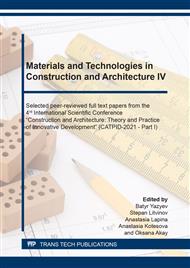p.109
p.115
p.121
p.127
p.133
p.141
p.149
p.155
p.163
Proposals for Determining the Relative Deformations Design Value of εb3 Concrete in Volumetric Deformation Conditions
Abstract:
The article presents the studies’ results on the deformability and strength of reinforced concrete racks reinforced with composite materials with the characteristics stretching beyond the limits established by the norms of Russia, namely: the λh structures flexibility exceeding the value 15, the ratio of the cross-section sides equal to 1.5 and the eccentricity of the load application e0 exceeding 0.1h. The results of the tested racks calculations are analyzed according to BC 164.1325800.2014, which in some cases confirmed the inexpediency of using composite materials. However, according to the results of our experiment, an increase in the strength of a number of racks with the characteristics that go beyond the recommended standards was found. The purpose of this study is to check the methodology for calculating Russian norms for the compressed reinforced concrete elements, the parameters of which are outside the limits recommended by the norms, to develop proposals for improving the calculation based on the obtained experimental data and to determine the concrete deformability effect on the change in bearing capacity. The article discusses flexible struts, reinforced with composite materials, located in the transverse direction. The experimental data results on the deformability of concrete and the strength of struts reinforced in the transverse direction are presented. The calculation methodology, compiled in accordance with Russian standards, the calculation results of which are the theoretical values of the deformability of concrete and the strength of the racks, is considered. After comparison, a significant underestimation of the theoretical strengths and a mismatch in the struts’ concrete deformations were revealed. It was found that the change in compressive deformations of concrete depends on the external composite reinforcement. Theoretical values , calculated according to the current standards, have significant discrepancies with the experimental ones. Based on the experiments’ results analysis, in the methodology of norms for calculating the ultimate compressive deformations of concrete the suggestions that take into account the type and percentage of composite reinforcement and ensure a good agreement between experimental and theoretical values have been made. After the introduction of the coefficient into normative calculation, new data on the theoretical strength of the struts were obtained, which showed significantly better convergence with the experimental data.
Info:
Periodical:
Pages:
155-162
Citation:
Online since:
August 2021
Authors:
Price:
Сopyright:
© 2021 Trans Tech Publications Ltd. All Rights Reserved
Share:
Citation:


